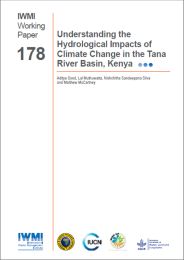IWMI Working Paper – 178
Citation:
Sood, A.; Muthuwatta, L.; Silva, N. S.; McCartney, M. 2017. Understanding the hydrological impacts of climate change in the Tana River Basin, Kenya. Colombo, Sri Lanka: International Water Management Institute (IWMI). 40p. (IWMI Working Paper 178). [doi: 10.5337/2017.220]
Abstract
The Tana River is one of Kenya’s most important rivers. It is the principal water source for Nairobi, the capital city, providing water for hydroelectric power generation and irrigation. Several of the flagship projects laid out in Vision 2030 – the blueprint that guides Kenya’s national development – are located in the basin. This report presents the findings of a study to determine the possible impacts of climate change on the hydrology of the basin. Data from seven Regional Circulation Models (RCMs), simulating two Representative Concentration Pathways (RCPs), were used as input to the Soil and Water Assessment Tool (SWAT) hydrological model. For both RCPs, rainfall is projected to increase across the basin over the remainder of the twenty-first century. Associated increases in water yield, groundwater recharge and baseflow point to an improved water resource situation in the future. However, declining natural flow regulation, increased variability, and considerable increases in the frequency and magnitude of floods pose a risk that threatens to undermine development opportunities. Water resource management will be much more difficult than under historic climatic conditions.
ISSN 2012-5763
e-ISSN 2478-1134
ISBN 978-92-9090-860-9


